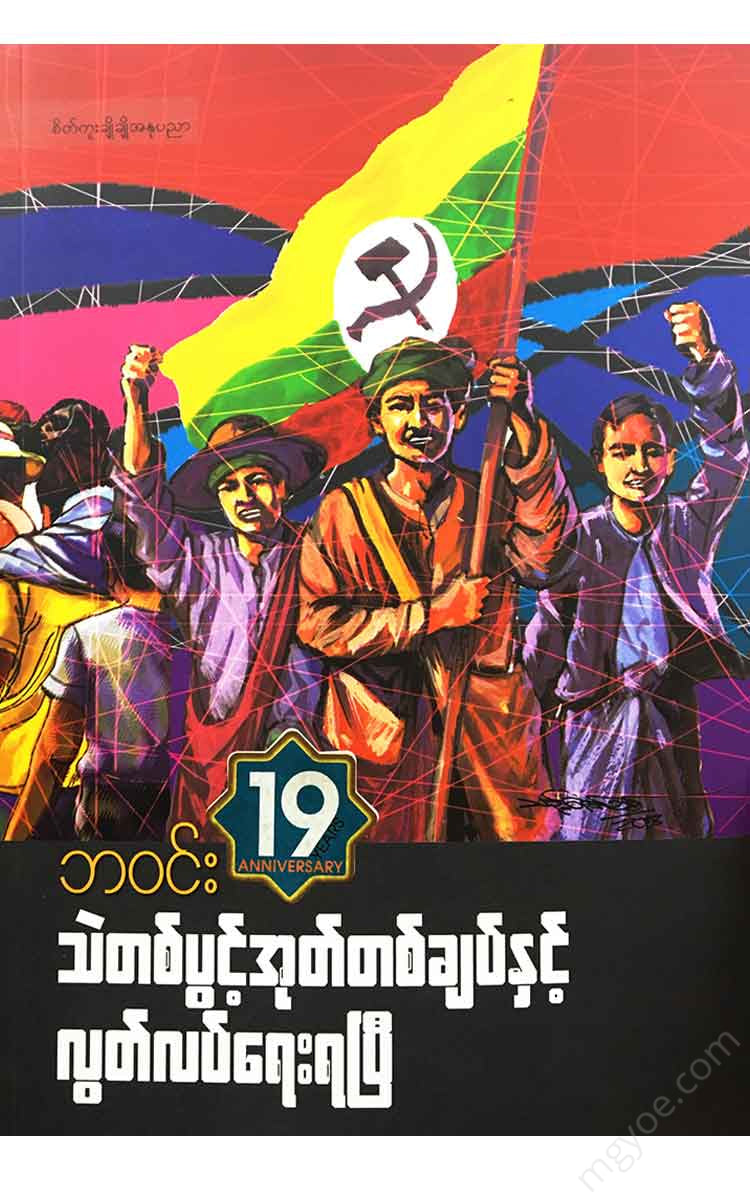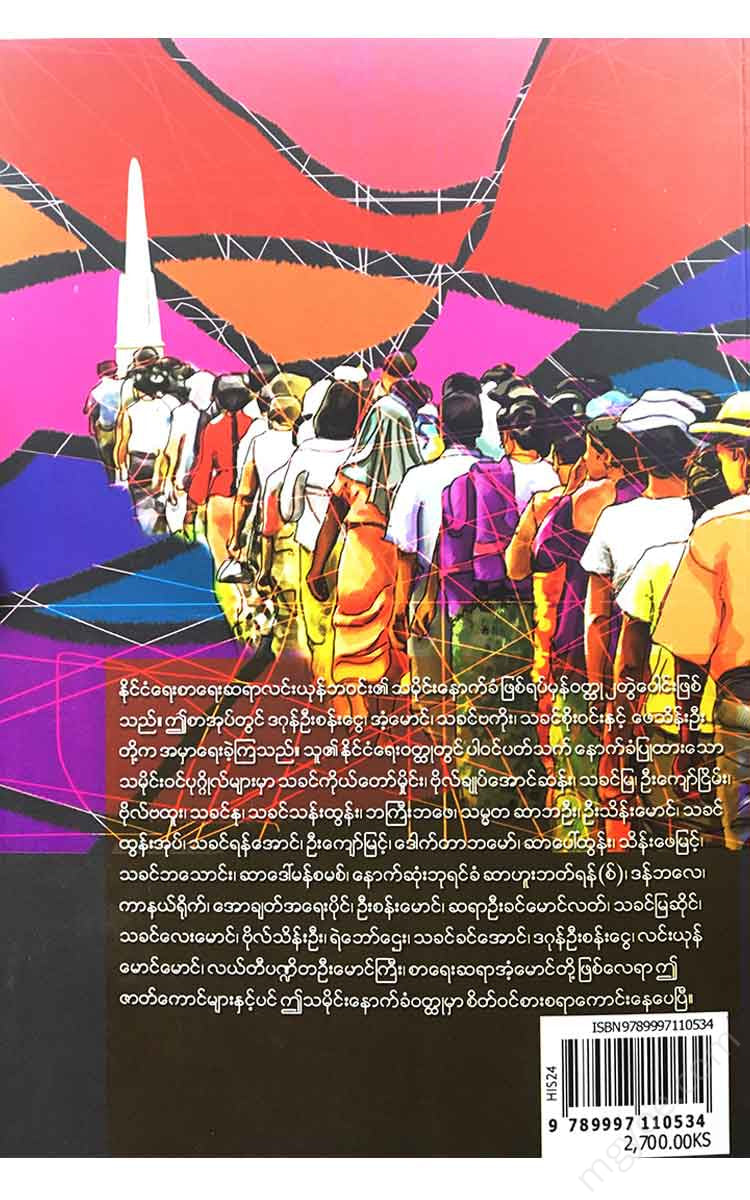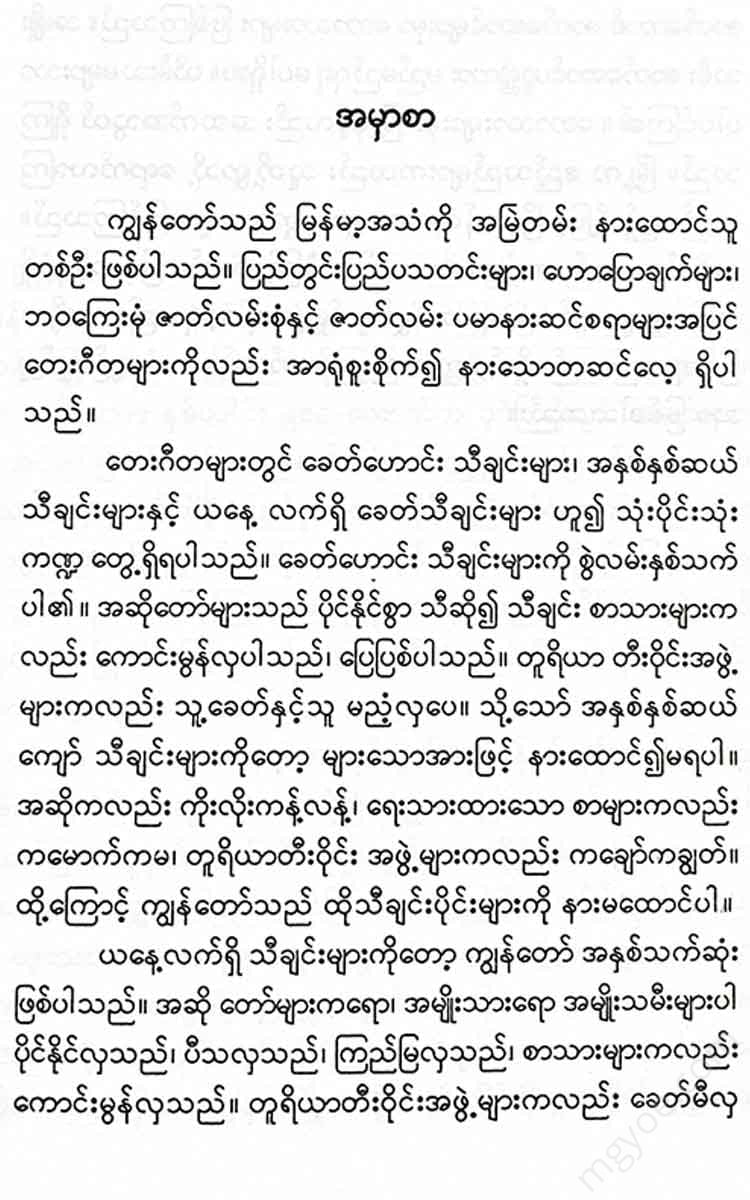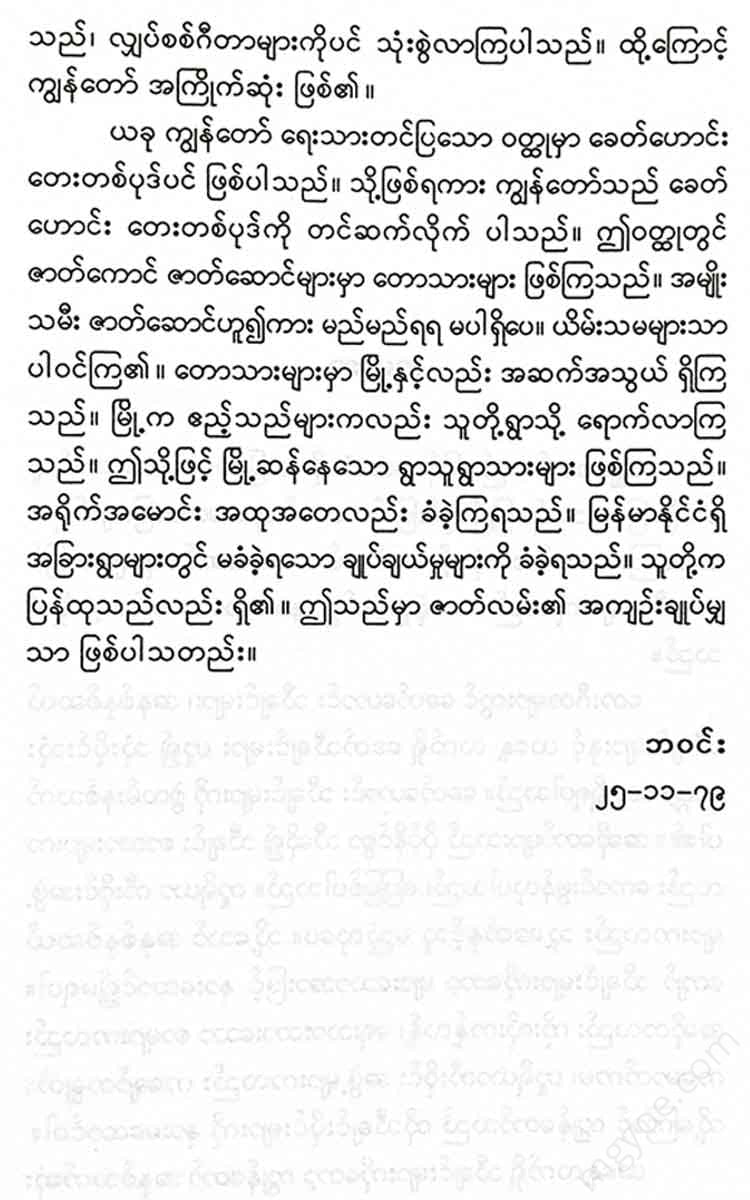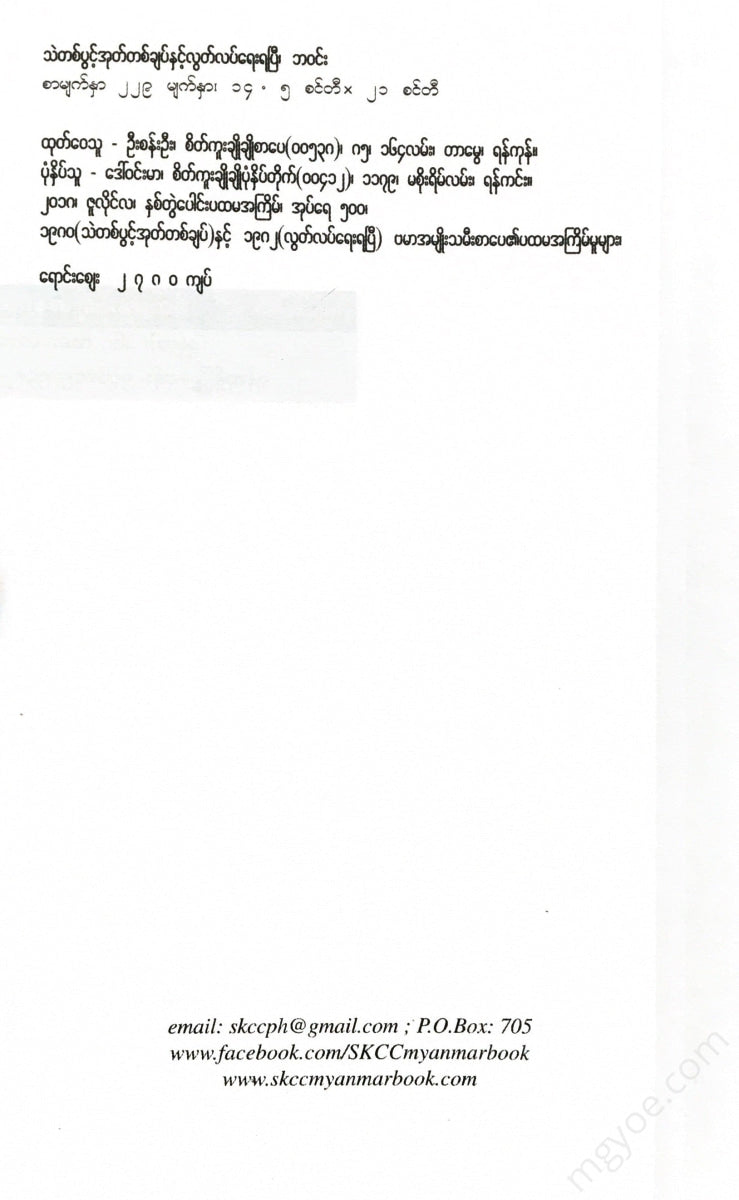စိတ်ကူးချိုချိုစာပေ
Bhavin - I have achieved freedom with a piece of sand and a piece of paper.
Bhavin - I have achieved freedom with a piece of sand and a piece of paper.
Couldn't load pickup availability
The name of this village is “Shwe Than”. The author has given this name in a poetic and economical way. It is also said that his real name is “Koe Than”. Their reason is as follows.
About 900 years ago, King Anawrahta ruled the kingdom of Bagan. At that time, a black merchant from India arrived and set up a trading post about four or five miles north of this place. The Burmese people at that time called him “Ba Thu Kywe.” The black merchant wanted to strengthen his trading post and requested an order from King Anawrahta to build a guest house.
Then King Anawrahta issued a decree that the palace of the trading post should be built with a pillar about the size of a knee and a pillar less than a foot long. If it were built with this size, it would only be a small hut. Therefore, the king came up with an idea. According to the saying, the palace pillar was about the size of a knee, and a piece of cowhide was cut, which was about the size of a foot long. For the pillar, the leather was cut again and the leather was stretched to the desired size. The palace pillar was built along the length of the leather, and the pillars were made in the same way. The palace became a magnificent and huge palace. In this way, the Burmese in that area began to call him “The Great and Wise King of the Kalan.”
This news reached the Golden Temple in Bagan, where King Anawrahta was furious and gathered a large army to punish the king. The army of 9 million soldiers was stationed in this village, so it was called “Ko Than”. The author does not know whether the army that Anawrahta camped included 9 million soldiers. However, the army camped to the east of the village, so it was called Bo Kone. To the northwest, where King Anawrahta camped, there was a village called Min Te. This is a research on the name “Ko Than”.
Alternatively, it could be thought that it was called "Sniffing" because it was seen from the eastern ridge, where the smoke was billowing.
Water and land conditions
The eastern mountain range gradually descends to the west. In some places it is flat. Then it descends again and becomes a flat plain. In these plains, people cultivate fields and grow fruits. The last place where Shwe Than village is located is Kamu Kalay. From there, as the village descends to the west, there is no more high ground. At the western end of this plain is a small, deep, and fast-flowing stream called Pauk Chaung. This stream flows north from Ok Pho Taung village in the headwaters and flows into the Chindwin River.
About half a mile north of Shwe Than village, there is a large Yama stream flowing from the Tha Si mountain range. This stream is called Tha Si stream. It flows from the east of Tha Si. However, it would be more accurate to call it Kho Than stream. Because it is the lifeblood of Kho Than Sha. After the rains from the east come, the stream flows slowly on the sand, turns northwest of Kho Than village, flows south, and reaches the end of the stream. In the north, it is filled with fine silt and sand, and in the south, it flows into the deep soil. The northern part, which is filled with fine silt and sand, is called Myay Za Daw. In the Myay Za Daw, corn fields, chickpea fields, broad beans, and medicinal plants used for rolling tobacco are cultivated in a lush green manner. In the deep soil called Khaing Ngwe Rin, wheat fields, chickpea fields, and onion fields are cultivated. Looking east from this forest, one can see the beautiful and majestic blue-and-white pagoda built in the village temple of Khotham village, located at the top of the mountain. The Buddha smiled happily with his eyes filled with the colors of the glass. The life of the villagers in this village is based on this water, this land, this wet land.
It seems to be a prophecy that there can be no poverty because of it.
- - ----
A united village
This village was a very united village. Even the neighboring villages were afraid of the unity of this village. The Sha people were not only united in their courage, but also when they had to face the government and the government, they were united and generous in contributing money without being favored over others.
Once, the Venerable Leti Sayadaw from Monywa came to this village. He was a disciple of the Venerable U Wisittha Monastery. The nuns and nuns from Kanbya village, located to the east of this monastery, invited him to come to their village and preach the Dhamma. As invited, the Venerable Leti came to the village and preached the Dhamma.
When the monk returned from this village, the villagers, who were very respectful after hearing the sermon, made a special arrangement to send the monk back. The method was as follows: The wheels of two ox carts were removed and the wheels were attached to a four-axle vehicle. Cloth sheets were spread out in front of the cart and used as ropes. The ropes were pulled by the devoted dayakas. In this way, the monk also rode peacefully on the vehicle pulled by the people.
Between the two lakes, the Kho Than villagers demanded that the cart be handed over because it was in their territory. The villagers of Kanpya who were pulling it refused to give it to them and said that they would pull it to the school. In this way, they fought over the cart, and the villagers of Kanpya were injured and fled. The Kho Than villagers saved money to sue for this matter. Since they had a lot of money, the case was dropped during the British colonial era. Regarding this matter, U Kyaw Hla, a master of the Than Cho from Maung Taung village, wrote a Than Cho and condemned the Kho Than village. His Than Cho ends as follows.
"Where will the teacher hide? The rock called Bo Kone, the scary village in the west, the shape of Moggallana, the hair on the back of the head, no need to part it, surrounded by stones and sticks."
He meant that the villagers of Kotham were beating and pelting the villagers of Kanpya with stones and sticks, just as the five hundred thieves beat and pelted the monks.
From traditional chief to voting chief
In this village, the traditional tradition of the chieftains as the chieftains was until the time of the last chieftain, U Kyauk Lone. The last traditional chieftain, U Kyauk Lone, was very steadfast, honorable, and did not follow the four evils, so he was respected by the villagers. The village chieftains were not as wealthy as the weavers and weavers.
He lived a simple life like an ordinary villager. When U Shwe Shan and U Ni Gyi had a dispute in the village, they acted as arbitrators and fairly investigated and resolved the dispute. The chief, U Kyauk Lone, did not even bother to interfere with his work. He even thanked him for helping him with his work. This was the only way to maintain unity in the village. Traditionally, when a father chief dies, his son always takes over. His son-in-law also takes over. Therefore, there were very few disagreements between the chief and the villagers.
When the traditional chieftain U Kyauk Lone died, his grandson Ko Daung Sein was to succeed him, but the British colonial government no longer accepted that system. It was decreed that the chieftain would have to be elected by popular vote.
Thus, four new chiefs emerged in the village. Among them, according to tradition, were (1) Ko Daung Sein, (2) Ko Pao, (3) Ko Ba Maung, and (4) Ko Ba Pe.
The candidates are campaigning in the village. The voters are criticizing who is good and who is bad. Conflicts arise not only among the candidates but also among the voters. The unity that has been strengthened over centuries is broken. They are running away like a bamboo forest.
During the election, an English mayor from Monywa arrived in Khotham village with three or four clerks. The first three candidates for mayor were graduates of English schools and surveyors. Thus, they were all natives. The fourth was a monk. Thanks to the support of the monks and nuns of the school he attended, he became a mayor. Ko Daung Sein, who had graduated from a Wesleyan school and who was supposed to be the only one to interact with the traditional system, did not dare to go out in public after losing the election. He was embarrassed. The third Ko Ba Maung, who had studied up to the seventh grade in the old days, was also embarrassed in the same way. He was thinking about those who voted for him and those who did not.
This village was no longer happy for them. Ko Daung Sein and Ko Ba Maung abandoned their children and wives and wandered off to other places. The culprit was the British colonial system. It had destroyed the unity of the village. Only Ko Pao and Ko Ba Pe, who had become the chief, were left in the village. In a village with a feudal system of life, the British colonialists' use of the voting system was like throwing a triangle into a rectangle. In this way, the valuable unity of the village was destroyed. Those who fled fled and those who remained were left behind, and the one in power raised the banner of pride. He first attacked those who did not vote for him and then ignored those who voted for him. The Englishman who had given him a letter of appointment considered him the only lord. The monastery that did not vote for him paid five kyats for the ceremony order at the Buddha festival, and the monastery that voted for him paid the same five kyats for the ceremony order at the Buddha festival.
And he started a business as a big weaving mill. He had to fight. He also got money from gamblers. He also got money from drinkers. When cattle and beef sellers came to his shop, he would ask for beef as a bribe. The price was very low. When there was a Buddha festival, the wealthy people would each take responsibility and feed about a hundred monks. He had never fed alms before, so his father even scolded him. “You are eating old food.” This meant that he did not give new alms, but lived on past alms.
The other person who was not elected as the chief who did not abandon his children and wife was also sleeping in the courtyard of his house during a night dance at a charity event in the village. He was also beaten while sleeping and was taken to the hospital for treatment. His injuries healed, but the injury was near his eyes, affecting both eyes and causing him to be completely blind. No one is to blame for these troubles. The real culprit is
